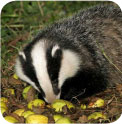 The European badger Meles Meles belongs to the Mustelidae family of mammals . Other species in this group include stoats, weasels, otter, pine marten, polecat and ferret. It is found across most of Europe and is particularly abundant in the UK. Badgers are protected under The Protection of Badgers Act 1992. This was brought into force in order to protect badgers from heavy persecution.
The European badger Meles Meles belongs to the Mustelidae family of mammals . Other species in this group include stoats, weasels, otter, pine marten, polecat and ferret. It is found across most of Europe and is particularly abundant in the UK. Badgers are protected under The Protection of Badgers Act 1992. This was brought into force in order to protect badgers from heavy persecution.
In the UK badgers will live in a range of habitats, but are most often found in woodlands in mosaic with pasture and arable for foraging. They prefer a slope to dig their setts, as this means the sett is more likely to be warm and dry.
There are several different categories of setts. The main sett is lived in all year round and used for breeding. It’s normally large, with a number of entrances, used and disused, and numerous well trodden paths. Other sett types include: annexe setts, with well worn paths to main sett and numerous entrances but is not always in use; subsidiary setts, not directly connected to other setts and not always in use; and outlier setts, with just 1 or 2 entrances and no defined paths and rarely used.
Badgers are omnivores, eating a wide range of animals and plants. With diet often depending on time of year, hence their preference for a range habitats to ensure a wider range of food sources for all year round. The main bulk of their diet is earthworms, but they will also eat insects, birds, small mammals, fruits and berries, cereals, reptiles and amphibians. They are more of a forager then a hunter so prey such as birds and small mammals make up a very small percentage of their overall diet.
Badgers can mate at any time of year, but the embryo does not imp-ant until winter. Cubs are born January-March and ranges from two to three.